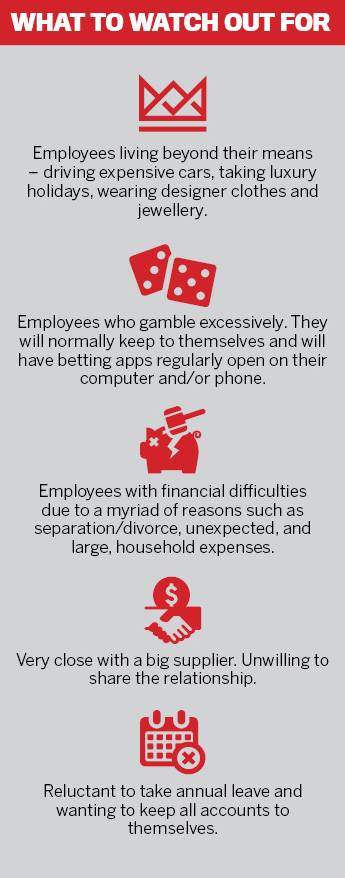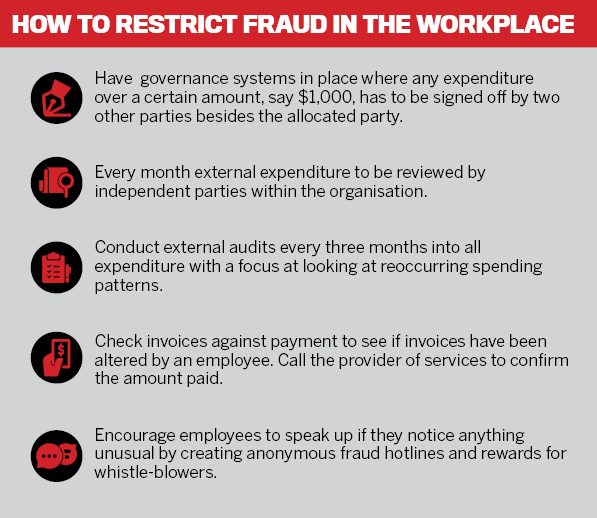
It's an issue that’s continually on the rise – yet leaders are reluctant to discuss

One of the many employment law concerns for leaders over the past few years has revolved around internal fraud. With money increasingly tight, people are turning to desperate measures to keep their standard of living viable. Personal identity theft is the most common crime in the world with 11% of Australians experienced personal fraud in 2020-21, up from 8.5% in 2014-15, according to the Australian Bureau of Statistics.
The increase was driven by a rise in card fraud (from 5.9% to 6.9%) and scams (from 2.4% to 3.6%).
Card fraud was the most common fraud type experienced in 2020-21 (6.9%). In the office, employees will often use company credit cards as an easy way of committing fraud. The Association of Certified Fraud Examiners survey reveals that 80% of business leaders have encountered fraud by an employee during their career.

“Employee fraud, also known as internal fraud, is a problem that businesses don’t like to talk about,” Alex Cherniakov, solutions consultant, fraud and compliance, at GBG, said. “Like with other types of fraud and scams, those that have been defrauded often feel a sense of shame, but the reality is that employee fraud happens every day and impacts businesses of all sizes. Employee fraud can range from a loss of a few dollars borrowed from a cash till to spectacular collapses of businesses. While smaller frauds are often not spoken about, larger frauds make it to the news. In 2010, an electronics retailer Clive Peeters, collapsed, following $20 million being stolen by an employee, without it being noticed for over two years.”
The temptation to steal doesn’t necessarily come from day one. An employee can find themselves in a difficult financial situation and become desperate to attain extra cash. For some people, it starts off slow, think Frank Tassone, the Rosyln Schools Superintendent (played by Hugh Jackman in the movie, ‘Bad Education’) who started off not declaring coffee receipts being bought to accumulating more than $US7 million.
One of the reasons Tassone was able to get away with the fraud for so long was that school administrator Pamela Gluckin was in on the scam as well, helping herself to $4.3 million.

Employers need to make sure that employee fraud is prevented or reduced. One of the easiest and most effective controls is a mandatory 10 consecutive days of annual leave for all employees. This ensures that another person would step into one’s role for the period and potentially identify any fraud that the employee might be trying to hide. In fact, an employee refusing to take leave is often a red flag an employer should be on the lookout for. Both Tassone and Gluckin spent many years in jail.
“Businesses of all sizes should have hard controls in place, to prevent accidental or opportunistic fraud,” Cherniakov added. “For example, a code to the safe should be known by a small number of employees, kept securely and changed regularly. The same rule should apply to any system access – access should be controlled, reviewed regularly, passwords updated periodically, and no access credentials should ever be shared between employees.
“Training is a good tool to reduce employee fraud. Educate your staff on what the red flags might be and educate them on how to report concerns. Do not be afraid of telling your staff that you are monitoring for the signs of internal fraud. Let everyone in the business be your eyes and ears to detect fraud, by telling them what to look for. Don’t tell employees what you are doing to detect fraud but do tell them that you take it seriously and have zero tolerance.”
Employee fraud is more common than you think. The stricter the controls in the place, the less chance of it happening.